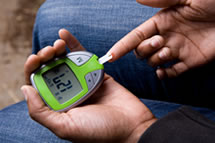
Emory University researchers say normal glucose levels should be the goal for management of patients with early type 2 diabetes mellitus (T2DM) and prediabetes.
In a commentary published online today in Nature Reviews Endocrinology, Lawrence S. Phillips, MD, and Darin E. Olson, MD, PhD write that “although T2DM is a major public health problem, few clinicians screen routinely to detect this problem early or manage hyperglycemia (high blood sugar) aggressively if it is found.” They say there is now evidence these practices should change.
The researchers based their statement on several pieces of evidence: A recent report from the Diabetes Prevention Program Outcomes Study (DPPOS) in The Lancet which showed there was less development of T2DM in those patients with prediabetes who were able to reduce their blood glucose to normal levels.
“How the normal glucose levels were achieved did not seem to matter,” says Phillips, a professor at the Atlanta VA Medical Center and in the division of endocrinology at Emory University School of Medicine.
“The benefit was comparable if patients used diet and exercise or took a diabetes drug – but there was more benefit if normal glucose was achieved several times compared to just once.”
Additional evidence included observations that T2DM and prediabetes adversely impact individuals and the healthcare system; progression from prediabetes to T2DM can be prevented or delayed by lifestyle changes or pharmacotherapy; preventing or delaying progression to T2DM is likely to improve important health outcomes; there are plausible biological mechanisms for the benefit to the body’s insulin-producing cells of maintaining normal glucose levels; and targeting normal glucose levels can be undertaken at little risk of harm to patients.
From the combined evidence, the researchers are making three recommendations for clinicians and healthcare systems:
1) Screen to identify patients with early T2DM and high-risk prediabetes (fasting glucose ≥110 mg/dl or two‑hour oral glucose tolerance test glucose ≥140 mg/dl). This screening would identify an estimated 22 percent of adults in the United States based on data from the National Health and Nutrition Examination Survey 2005–2006. Screening should be systematic and aimed at patients who are at risk on the basis of age, weight or other characteristics and testing should be repeated, if negative, at a cost-effective frequency—about every three years.
2) Treat high-risk patients aggressively, beginning with an intensive lifestyle intervention (diet and exercise), and intensifying treatment progressively with addition of drug therapy as needed to achieve normal glucose levels.
3) Conduct a randomized, controlled trial in patients with early T2DM and high-risk prediabetes to evaluate the benefits, risks and costs of patient management aimed at achieving normal glucose levels.
“The trial we call for is needed to provide optimal evidence, but we believe that the time to begin changing medical practice is now,” says Olson, an assistant professor at the Atlanta VA Medical Center and in the division of endocrinology at Emory University School of Medicine.
Prediabetes and T2DM are metabolic disorders that are due to inability of the body’s insulin-producing cells to make enough insulin to keep blood glucose levels in the normal range. Over time, these disorders can lead to blindness, kidney failure, nerve damage, heart attacks and strokes.
Pre-diabetes is a condition that occurs when a person's blood glucose levels are higher than normal but not high enough for a diagnosis of type 2 diabetes. Many patients with prediabetes go on to develop T2DM.
